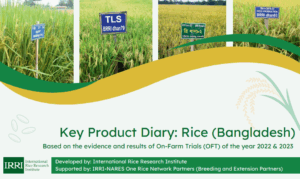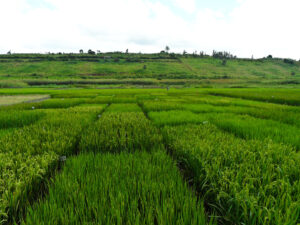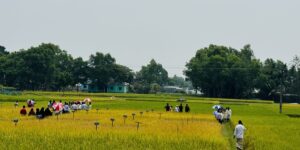The beneficial farming principles of conservation agriculture are not yet adopted widely in rice-based cropping systems particularly in South Asia. A novel solution to overcome these problems can be non–puddled rice crop establishment practice which, in some environments and soils, has been reported to perform well in terms of yield increase, soil properties improvement, global warming mitigation, and economic return.
Fitting novel rice establishment practices in the wetland rice–upland crop intensive cropping systems has always been a challenge. The benefits of following minimum soil disturbance and crop residue retention for establishing upland crops may be destroyed during establishing rice crop by puddling.
To fit conservation agriculture (CA) in rice-based triple cropping systems, puddling has been replaced by direct seeding of rice (dry, wet, and water seeding), but they have their own demerits for the timeliness, labor use, water productivity, input requirement, drudgery, fuel consumption, energy use, yield sacrifice, economic return, and GHG fluxes.
Accordingly, the beneficial farming principles of CA are not yet adopted widely in rice-based cropping systems particularly in South Asia. A novel solution to overcome these problems can be non–puddled rice crop establishment practice which, in some environments and soils, has been reported to perform well in terms of yield increase, soil properties improvement, global warming mitigation, and economic return.
More research is needed in diversified soils and cropping systems to showcase the potentials of CA cropping so that farmers, as well as policymakers, see the merits of adopting CA cropping in the Eastern Gangetic Plains (EGA).
Yield sustainability of CA cropping over time is based on soil fertility improvement which occurs by following its principles (minimal disturbance of soil, crop residue retention, and growing crops in rotation). Long-term studies indicate that zero or minimum soil disturbance either improves or maintains soil fertility and productivity and similarly increases or gives similar crop yields in comparison with conventional cropping systems.
In addition, crop residue retention builds soil organic matter level and nitrogen reserves and also influences soil nutrient availability. Soil physical and biological properties are also influenced by crop residue retention. Appropriate crop rotation reduces weed infestation and fertilizer inputs use, increases nitrogen (N) availability, maintains soil fertility, and thereby increases crop yields.
Legumes, such as lentil, in the cropping sequence, have the potential to enhance soil N concentration by fixing atmospheric N. Jute, an important cash crop in Bangladesh, drops large amounts of leaf litter to the soil during crop growth, which improves the physical and chemical characteristics of the soil. Soils of rice-based double—or triple—cropping accumulate a significant amount of nutrients over time, even with the removal of all aboveground biomass from the field and without organic manure application.
Many previous studies reported that CA practices increase crop yield by improving soil fertility, conserving soil water, and sequestering organic carbon in farm soils. But very few studies report how CA cropping was applied to rice-upland cropping systems in the low-lying areas which prevail in the Eastern Gangetic Plains and other parts of Bangladesh. The alteration of soil properties under the CA cropping (non-puddled transplanting of rice and strip planting and bed planting for upland crops) in rice-based cropping systems in the low-lying areas has also not been reported.
A range of cropping systems (more than 300) is practiced on the EGP depending on the land types and the availability of irrigation water. Jute is common in the flooded area of the EGP and the component crops are grown by traditional crop establishment practices. As a result, soil health has been reported to deteriorate and nutrient mining has occurred under the traditional practices all over the EGP and Bangladesh.
Limited research has been done on CA practice on light-textured soils in seasonally flooded lands that support the rice-jute cropping system. Soils with lower organic matter content and sandy texture can respond more to the implementation of a CA in terms of soil health and crop yield than loam and clay textured soils.
However, the adoption of minimal soil disturbance (strip tillage/bed planting/zero tillage for upland crops and non-puddling for rice) and residue retention for all component crops in intensive triple cropping systems can alter the stratification and availability of nutrients in the soil.
Few studies have been done to record the alterations in terms of soil health, crop yield, and economics of the complete CA cropping which are required for a complete assessment of CA cropping in the Gangetic Plains.
The study was, therefore, conducted to measure changes in physical properties, soil organic matter, soil nutrient concentrations yields, and profitability of crops in the monsoon rice-lentil/wheat-jute cropping system under different crop establishment and crop residue retention practices.
Read the study:
Salahin N, Jahiruddin M, Islam MR, Alam MK, Haque ME, Ahmed S, Baazeem A, Hadifa A, EL Sabagh A, Bell RW. (2021) Establishment of Crops under Minimal Soil Disturbance and Crop Residue Retention in Rice-Based Cropping System: Yield Advantage, Soil Health Improvement, and Economic Benefit. Land: 10(6):581.






